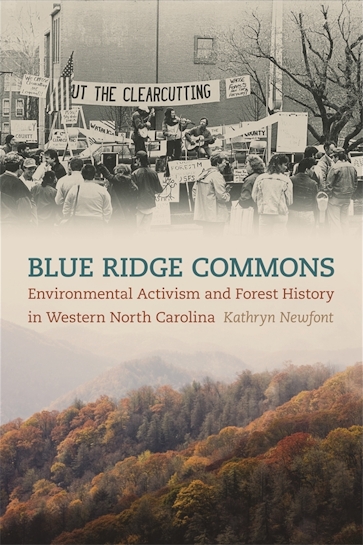Blue Ridge Commons
Environmental Activism and Forest History in Western North Carolina
Title Details
Pages: 400
Illustrations: 12 b&w photos
Trim size: 6.000in x 9.000in
Formats
Paperback
Pub Date: 02/01/2012
ISBN: 9-780-8203-4125-5
List Price: $41.95
Hardcover
Pub Date: 02/01/2012
ISBN: 9-780-8203-4124-8
List Price: $120.95
Blue Ridge Commons
Environmental Activism and Forest History in Western North Carolina
Skip to
- Description
- Reviews
- Awards
In the late twentieth century, residents of the Blue Ridge mountains in western North Carolina fiercely resisted certain environmental efforts, even while launching aggressive initiatives of their own. Kathryn Newfont examines the environmental history of this region over the course of three hundred years, identifying what she calls commons environmentalism—a cultural strain of conservation in American history that has gone largely unexplored.
Efforts in the 1970s to expand federal wilderness areas in the Pisgah and Nantahala national forests generated strong opposition. For many mountain residents the idea of unspoiled wilderness seemed economically unsound, historically dishonest, and elitist. Newfont shows that local people’s sense of commons environmentalism required access to the forests that they viewed as semipublic places for hunting, fishing, and working. Policies that removed large tracts from use were perceived as “enclosure” and resisted.
These battles often pitted industrialists against environmentalists. Newfont argues that the side that most effectively hitched its cause to local residents’ commons culture usually won. A few perceptive activists realized that the same cultural ground that yielded wilderness opposition could also produce ambitious protection efforts, such as Blue Ridge residents’ opposition to petroleum exploration and clearcut timber harvesting.
Incorporating deep archival work and years of interviews and conversations with Appalachian residents, Blue Ridge Commons reveals a tradition of people building robust forest protection movements on their own terms.
The Blue Ridge forests, and the human communities they have sustained, have found in Kathryn Newfont an historian who deftly captures their cultural significance and environmental import. Blue Ridge Commons provides a close reading of local aspirations and needs, and suggests how what has happened in these particular mountains also has been manifest across the nation and globe. It is an inspired contribution to the writing of American environmental history.
—Char Miller, author of Ground Work: Conservation in American Environmental Culture
Very well written and carefully researched, Blue Ridge Commons breaks new ground in Appalachian history and in our broader understanding of the politics of environmental movements. Newfont's central premise, the idea of commons environmentalism, is timely both for historians and for environmental activists, and her book will be recognized down the road, I believe, as a seminal publication that helped to change the way we understand Appalachian culture and its complex relationship to the land.
—Ronald Eller, author of Uneven Ground: Appalachia since 1945
Newfont’s book is not just eye opening but very well written.
—North Carolina Historical Review
Blue Ridge Commons makes a valuable contribution to the growing field of southern environmental history. . . . Anyone ever left deeply unsatisfied by the rhetorical dichotomy of ‘jobs-versus-the-environment’ will find great satisfaction in the framework of commons environmentalism and the new ways Newfont helps us understand. . .
—Sarah Mittlefehldt, Journal of Southern History
Winner
Weatherford Award, Appalachian Studies Association
Winner
Thomas Wolfe Memorial Literary Award, Western North Carolina Historical Association



